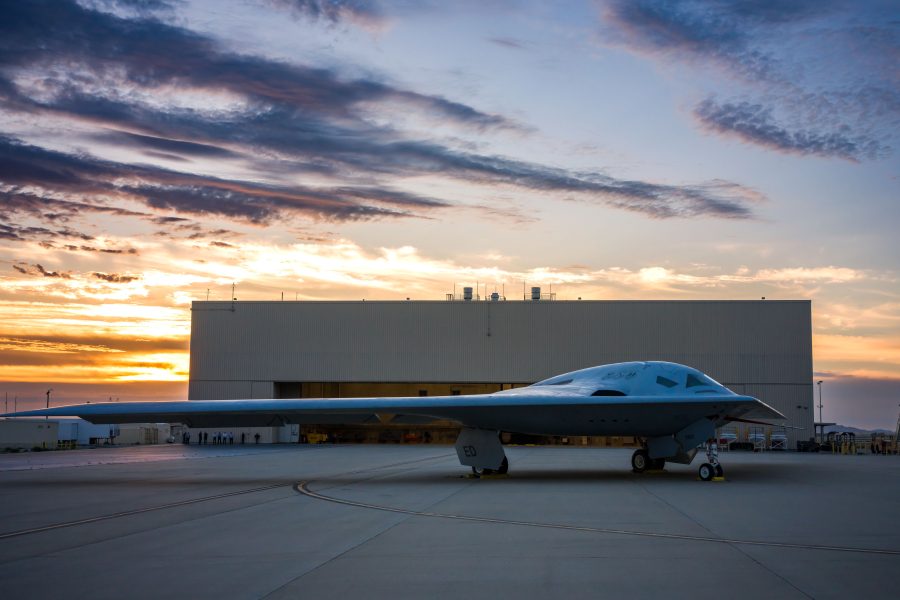While the Air Force eagerly awaits the first flight of the B-21, there aren’t enough Raiders behind that first aircraft in the pipeline to do everything the nation needs the bomber fleet to do, a top analyst said Sept. 13 at AFA’s Air, Space & Cyber Conference.
As a result, USAF’s bomber fleet, already smaller than it has ever been, could get even smaller if the Air Force doesn’t ramp up B-21 production or extend the service of the B-1 and B-2 fleets, said Mark Gunzinger, director of future concepts and capability studies at the Mitchell Institute for Aerospace Studies during a panel discussion on the B-21.
Northrop Grumman’s aeronautics president Tom Jones, also on the panel, said the first B-21, now being readied for flight test, is still likely to fly by the end of the year—and delays to this point are only a sign that it is being readied in a deliberate fashion that will ensure a quick succession of follow-on flights.
Gunzinger said his analysis of USAF aircraft inventory plans shows the bomber inventory will decline early in the next decade, at a time when its importance is only increasing.
“According to DOD’s own unclassified report to Congress of aircraft inventory, it looks like the B-21 acquisition rate is going to top out at around 10 per year sometime in the 2030s,” Gunzinger said. That level would be “half the max rate that we planned for the last four bomber models” and not enough to prosecute a campaign-level air war.
Also on the panel were William D. Bailey, the head of the Air Force Rapid Capabilities Office, which is developing the B-21; Jones; and Brig. Gen. Ty Neuman, the Air Force’s director of concepts and strategy in the Air Force Futures office. None disputed Gunzinger’s assessment.
To deter China from attempting an invasion of Taiwan, “we have to bring mass,” Gunzinger said. “We have to bring precision plus mass over long ranges to strike a … landing wave, surface action groups, and other targets that would be the core of China’s offensive strategy.”
Carrier air wings will have to stay too far away from China because of long-range ballistic missiles, Gunzinger said. “So we need our bomber force now more than ever.”
At 141 aircraft, today’s bomber fleet is smaller than at almost any time in USAF history. “We’re sized for the wars of the past and not the operating environment we’re in today,” Gunzinger said.
Various analysts peg a mixed fleet of 300 B-21s and B-52s as the minimum needed to carry out such an air campaign, but the Air Force doesn’t have the resources to do that because, for 31 years, it has received less funding than the Army or Navy.
A suggestion from former Chief of Staff Gen. David Goldfein that the Air Force move toward 225 bombers is a “step in the right direction,” Gunzinger said.
“We need to grow the size of our bomber force as quickly as possible, he argued. “And that means the acquisition rate of the B-21 should be maximized.”
In the meantime, “our force is going to go down before it goes up,” Gunzinger warned, explaining that DOD’s aircraft plan puts the bomber fleet at 133 tails. “It might actually be worse than that,” because the Air Force doesn’t have the money to keep the B-1 and B-2 bombers flying while bringing on B-21s.
Jones said the first B-21 test aircraft, designated T-1, is not a prototype and was built largely as the first production aircraft, P-1, will be.
“The jet that’s going to fly this year, for all intents and purposes, is a production jet,” Jones said.
“It’s got all the coating, it’s got the mission systems. It was built using factory processes. It was built with regular work orders by regular factory technicians, not engineers doing a bespoke first article. It was built with original tooling,” said Jones. While it will be a flight sciences aircraft, the B-21 contract calls for making the test airplanes into operational models later on.
As lessons are learned in testing, Northrop is applying adaptive processes, “which means we’re going to get to stable, steady production rates faster,” Jones promised.
Additionally,, B-21 sustainment was a foundational design factor, which means testing will move out rapidly and early production aircraft will be able to operate as “daily flyers” soon after reaching the force, he said.
Neuman said the Air Force is “thinking very differently” about how the B-21 will be employed versus previous bombers.
“It’s not about force packaging,” he said. “It’s about providing complicated scenarios that the adversary has to plan for,” as part of a “cost-imposing” strategy.
Bailey agreed that the B-21 is “still on track” to fly by the end of 2022.
“The aircraft is performing well,” he said. While the team is looking forward to first flight, in a meeting last week, they “wanted to talk about second flight up to the 20th flight. … We’re looking downstream all the time.”
The challenge, he said, “is to stay focused. We need to be ready on day one to operate this aircraft.”


